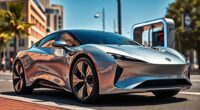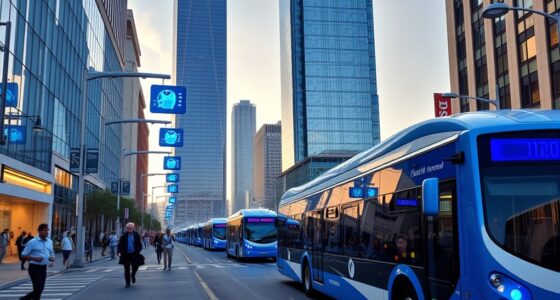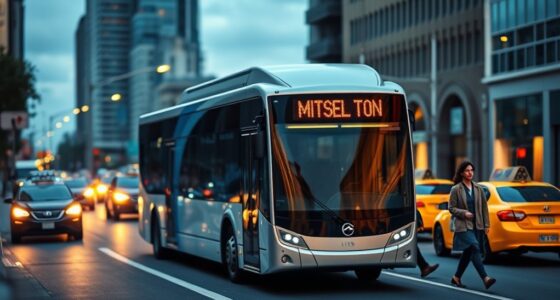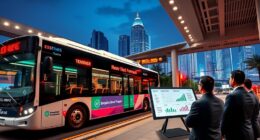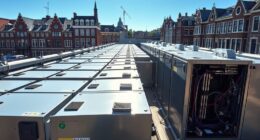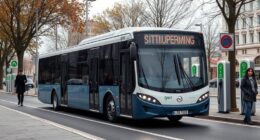Los Angeles Metro’s shift to 500 electric buses shows how a strategic, phased approach minimizes risks while boosting sustainability. You’ll see significant infrastructure upgrades, like high-capacity charging stations and grid enhancements, aligned with a smooth replacement process. The benefits include cleaner air, lower maintenance costs, and improved reliability. If you keep exploring, you’ll discover valuable lessons on integrating technology, planning, and community impact that can guide successful transit overhauls.
Key Takeaways
- A phased rollout minimizes risks and allows data-driven adjustments for integrating 500 electric buses.
- Strategic infrastructure upgrades, including high-capacity charging stations, are crucial for reliable operations.
- Collaboration with utility providers ensures sufficient power supply and supports grid capacity for the electric fleet.
- Data collection and analysis optimize charging schedules, enhancing efficiency and reducing downtime.
- Continuous technological improvements and infrastructure investments position LA Metro as a leader in sustainable transit.
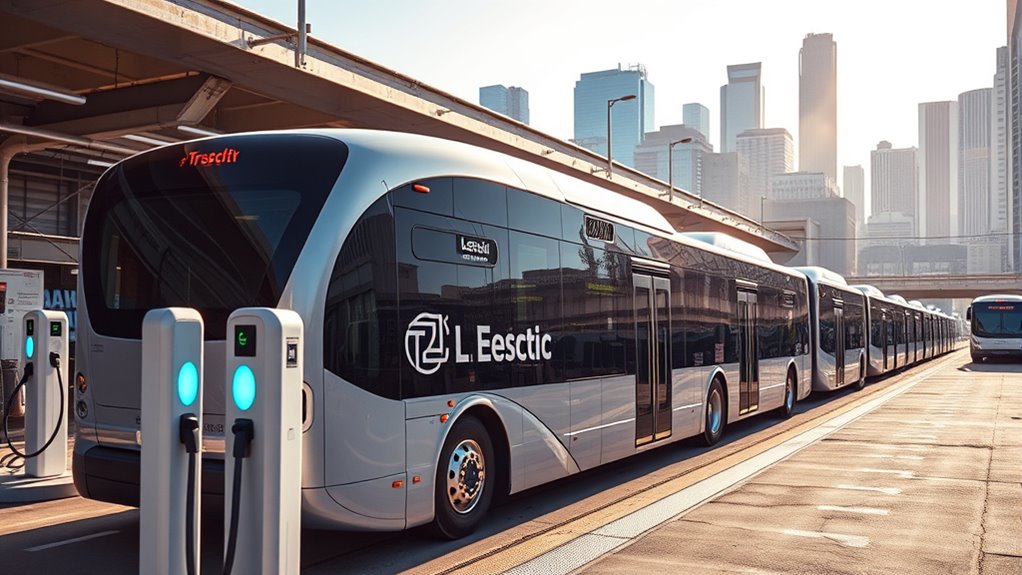
Los Angeles Metro is implementing a thorough transition plan to enhance its transit services and better serve the community. One of the key elements of this plan is bus electrification, which aims to replace traditional diesel buses with cleaner, more sustainable electric models. Moving to electric buses isn’t just about swapping vehicles; it requires a comprehensive approach that includes significant infrastructure upgrades. These upgrades are vital to support the new fleet, ensuring that charging stations are strategically placed and capable of handling the increased energy demands.
Los Angeles Metro’s bus electrification includes critical infrastructure upgrades for a sustainable transit future.
As you look into the plan, you’ll find that the focus on bus electrification is driven by both environmental goals and operational efficiency. Electric buses produce zero tailpipe emissions, helping improve air quality across Los Angeles, a city often challenged by smog and pollution. Furthermore, electric buses tend to have lower maintenance costs and better performance, which can translate into savings for the transit agency and more reliable service for you. The shift to electric vehicles is a substantial investment, but one that aligns with a vision of a cleaner, healthier city.
To make this transition successful, Metro is prioritizing infrastructure upgrades that support the new electric fleet. This involves installing high-capacity charging stations at key depots and along major routes. These charging stations are designed to quickly recharge buses during shifts, reducing downtime and keeping buses on schedule. Upgrading electrical infrastructure citywide is also necessary to handle the increased power load, which means working closely with utility providers to ensure the grid can support widespread electric bus operations. These investments are carefully planned to minimize disruptions and maximize efficiency.
You’ll notice that Metro’s approach emphasizes phased implementation, gradually replacing diesel buses with electric ones as infrastructure becomes ready. This phased strategy reduces risks and allows for adjustments based on real-world experience. During this process, data collection and analysis are critical; they help identify bottlenecks and optimize charging schedules. The goal is to create a seamless transition that maintains reliable service without interruptions.
Ultimately, the move toward bus electrification and infrastructure upgrades reflects a broader commitment to sustainability and modernization. By upgrading the infrastructure to support electric buses, Los Angeles Metro is not only reducing emissions but also setting a precedent for other transit agencies. This comprehensive approach ensures that the city’s transit system becomes more resilient, environmentally friendly, and efficient. As a rider, you’ll benefit from cleaner air, more reliable buses, and a transit system that’s aligned with the city’s long-term sustainability goals. Additionally, ongoing innovations in electric vehicle technology will continue to improve the performance and cost-effectiveness of the fleet.
Frequently Asked Questions
How Does the Transition Impact Daily Bus Service?
The shift causes bus schedule adjustments, which may lead to temporary delays or rerouted services. You’ll notice changes in the passenger experience, such as quieter rides and improved comfort with electric buses. While these shifts might initially cause some inconvenience, they ultimately enhance reliability and reduce emissions. Stay informed about schedule updates to navigate the changes smoothly, and enjoy the benefits of a greener, more efficient transit system.
What Is the Total Budget for the Electric Bus Project?
Imagine a sizable investment in your city’s future—Los Angeles Metro’s electric bus project has a budget allocation of around $300 million. Through careful fiscal planning, this amount is allocated to guarantee a smooth shift to cleaner transportation. You can see how strategic budget management supports this initiative, helping to modernize the transit system while balancing costs. This investment paves the way for a more sustainable and efficient public transportation network.
How Will Maintenance Needs Change With Electric Buses?
Your maintenance needs will shift toward battery maintenance and managing charging infrastructure. Electric buses require regular battery checkups and monitoring to guarantee peak performance, unlike traditional engine repairs. You’ll also need to maintain and expand charging stations, which means scheduling charging times and keeping equipment in good condition. Overall, maintenance becomes more focused on electrical systems and less on mechanical parts, streamlining your upkeep and reducing long-term costs.
Are There Plans to Expand Charging Infrastructure Citywide?
Think of the city’s charging infrastructure as a growing garden—gonna need more room to flourish. Yes, there are plans to expand charging stations citywide, ensuring electric buses stay charged and ready. This expansion considers grid capacity, so the power supply remains reliable without overloading. By increasing charging stations strategically, LA aims to support its electric fleet efficiently and sustainably, keeping the city moving smoothly and cleanly.
What Timeline Is Expected for Full Electric Bus Adoption?
You can expect full electric bus adoption within the next decade, as Los Angeles Metro plans to phase out diesel buses gradually. Advances in battery technology are speeding up this evolution, allowing for longer ranges and shorter charging times. The city is also expanding charging stations citywide, ensuring buses can recharge efficiently. This timeline balances technological progress and infrastructure development, making a cleaner, more sustainable transit system achievable soon.
Conclusion
As you watch Los Angeles Metro’s electric buses glide silently through the bustling streets, you see a city transforming before your eyes. The gray smog lifts, replaced by clear blue skies, and the hum of engines gives way to a peaceful quiet. This shift isn’t just about buses—it’s about breathing easier and shaping a cleaner future. With each electric mile, LA moves closer to a vibrant, sustainable city you can be proud of.

